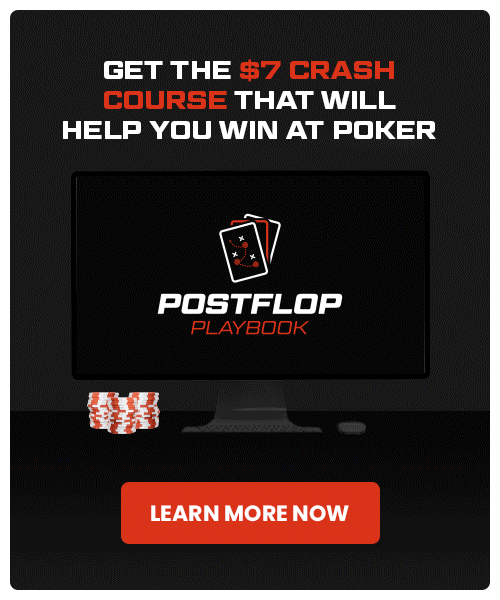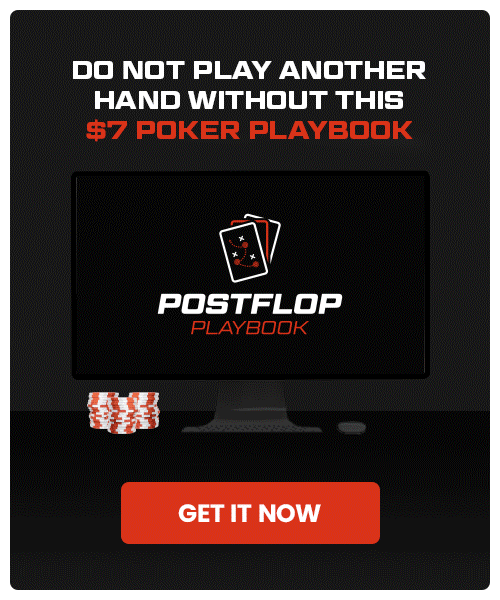Flush vs Flush! Rampage Flops The Nuts vs Nik Airball (Analysis)
Today we’re going to look at a massive pot between two high stakes Hustler Casino Live regulars: Rampage Poker and Nik Airball.
This is a wild pot that took place in a $25/$50 game with roughly $90,000 effective stacks.
Let’s jump in!
Preflop Action
Nik Airball straddles in the Cutoff to $100 (it’s called a Mississippi straddle), so the action starts on the Button who folds.
Rampage open-raises to $500 with from the Small Blind. Andy 3-bets from UTG with to $1,500. Nik Airball calls the from the Cutoff with . Rampage calls.
Note: Do not play another hand without this $7 Postflop Playbook! With such a low price tag, Doug Polk’s Postflop Playbook is a no-brainer buy if you want to nail down your fundamentals and build a bigger bankroll. Level-up your poker skills now!
Preflop Analysis
This is an unusual preflop action given the Mississippi straddle dynamic. Nonetheless, I will give you the best strategy that I can think off, without any sort of preflop simulations being available.
Rampage is out of position against 7 players, and he will be out of position against all of them postflop. This means that he should play an extremely tight strategy as he is at an enormous strategic disadvantage, being forced to always act first.
I would advise raising with roughly the top 7-8% of hands in this spot. That would include Pocket Eights or better, Ace-Queen offsuit or better, and suited broadways.
This might seem unnecessarily tight, but if you calculate the cumulative 3-betting frequency of the players left to act and add that to the fact of always playing out of position with a very high stack-to-pot ratio (SPR), raising even tighter than this might be the best course of action.
Now, granted, A8-suited is not far from that list of hands. But choosing to open-raise to 5x the size of the straddle means that you are risking a lot to win a little. This puts a large amount of mathematical pressure on him to win the pot at a very high frequency.
He is risking $500 to win $675, meaning that he needs to win the pot >74% of the time to profit. This is extremely improbable to happen with A8-suited over the long term no matter what kind of postflop edge you have over the other players.
Andy has a very strong preflop hand with , and a 3-bet is probably going to be slightly profitable in theory. I am saying slightly because Rampage should be open-raising an extremely tight range to begin with.
In practice, given that we see this A8-suited from Rampage, 3-betting with Ace-Queen offsuit is going to be highly lucrative. His 3-bet size is a good choice, putting enough pressure on Rampage’s range while still forcing him to continue with some weaker hands.
Nik Airball makes an extremely loose call here. It certainly has a very negative expectation given that he is likely up against extremely strong ranges to begin with. If you couple that with his horrible pot odds and the fact that Rampage can still 4-bet behind him, then it’s a recipe for a bad outcome.
Flop Action
The flop comes . The pot is $4,600.
Rampage checks. Andy bets $1,700. Nik raises to $5,000. Rampage 3-bets to $13,000. Andy folds. Nik calls.
Flop Analysis
An action flop gives Rampage the nut flush and Nik a small flush.
Rampage makes a standard check to the preflop raiser as he doesn’t have the nut or range advantage on this type of flop.
Andy should be looking to check with his entire range in this spot. This is due to being out of position against Nik’s highly condensed range and Rampage’s uncapped range (i.e. Rampage can have a good amount of flushes in his range).
Firing a c-bet here likely has a lower expected value (EV) than checking, and it might even be -EV given that he has very little equity against the range that calls.
Nik’s raise is fine; he has an extremely strong hand. I do, however, think that keeping the pot smaller with such a low flush, especially multiway, is a better course of action. While the hand might be alluringly strong on the flop, it shrivels up as a lot of money gets put into the pot.
Rampage’s 3-bet is fine too, but it’s hard to say if it’s better than calling. If he was in position, it would be easy to argue for a call as he would get to decide the size of the pot on the turn. But since he is out of position, raising and taking charge of the pot seems like a good option with the nut flush.
He could perceivably balance this range out by also 3-betting with some hands like or , for example. His 3-bet size is good. In theory, he wants to be able to spread the betting out across 3 streets so that he gets to deny the most amount of equity possible. Raising to a small size allows him to do that.
Andy’s decision to fold is straightforward here with nothing.
Back to Nik, who has an easy decision to call with his flopped flush. Folding the flush here would be too presumptuous, though he should recognize that Rampage is representing a stronger flush and proceed with caution on future streets.
Turn Action
The turn comes the , making the board . The pot is $32,300.
Rampage checks. Nik checks back.
Turn Analysis
A turn that is better for Nik as Rampage’s probable bluffs have not been completed.
Given that most of his range is either the nuts or blocking the nuts, Rampage should continue with the aggression, building the pot so he can win Nik’s entire stack. With a nice $14,000-$15,000 bet, he is setting up for a pot-sized shove on the river, which would close to maximize both his value and the amount of equity that his bluffs would deny.
Checking here is a mistake given that Nik almost certainly has a flush or a flopped set himself. If Rampage checks and Nik checks back, then he will allow Nik to sometimes hit a full house and cooler him, or have the 4th heart roll off and kill the action.
Nik’s check-back is the perfect decision here as he has a pure bluff-catcher at this point given the action on the flop. Betting wouldn’t accomplish much of anything since Rampage either has him beat or is drawing to beat him. But he can easily get away on the river 4-flush, for example.
There’s a small caveat here: Nik could potentially make a small bet here, something like 20-25% of the pot, giving Rampage direct odds if he has the . This move could manipulate Rampage into playing his range “face up” — check-calling with his nut flush draws and check-raising with his slow-played nut flushes.
River Action
The river comes the , making the board . The pot is $32,300.
Rampage bets $55,000.
River Analysis
All draws miss, which means that Rampage most likely has either a slow-played nut flush or a missed nut flush draw.
He should not only be over-betting in this “nuts or nothing” scenario, he should be going all-in. This way he gets to maximize the amount of bluffs that can “win the pot” (in GTO if you bet with a perfectly balanced range, all those bluffs are considered to have won the pot, as there is no edge to be gained by pure bluff-catchers).
Nik has one question to ask himself: Is Rampage going to bet this size more than 39% of the time with a bluff? (calculation based off of the pot odds offered to him by Rampage – 55000/(55000×2+32300).
If he wants to go with the more theoretically based strategy, then he could consider what his range is and defend a certain percentage of it in order to deny Rampage a profitable bluff.
In this case, he’d need to defend with (1 – 55000/87300 =) 37% of his range. This calculation is obviously impossible to make in real-time, in a spot that never happens more than once in his life (after cold-calling a 3-bet from the Cutoff straddle).
Results
Nik Airball calls and gets the bad news. Rampage scoops the $142,300 pot.
Do you think Nik Airball made a good or bad call on the river?
Let me know in the comments below.
Different blind structures make for interesting, unique scenarios and it’s awesome to see them play out in real-time. This type of straddle changes the game dynamic similar to how changing the starting position of the pieces in chess (such as in a Fischer random game) changes the entire dynamic.
That’s all for this article! I hope you enjoyed it and that you learned from it!
Want more poker hand analysis? Check out Flopped Quads vs LLinusLLove ($194,718 Pot Analysis).
Till’ next time, good luck, grinders!
Note: World-class pro Doug Polk has created a new poker crash course called The Postflop Playbook, which costs just $7 and takes less than 2 hours to complete.
When you get The Postflop Playbook, you will learn how to make quick and profitable decisions that translate to more (and bigger) winning poker sessions. Learn more now!

